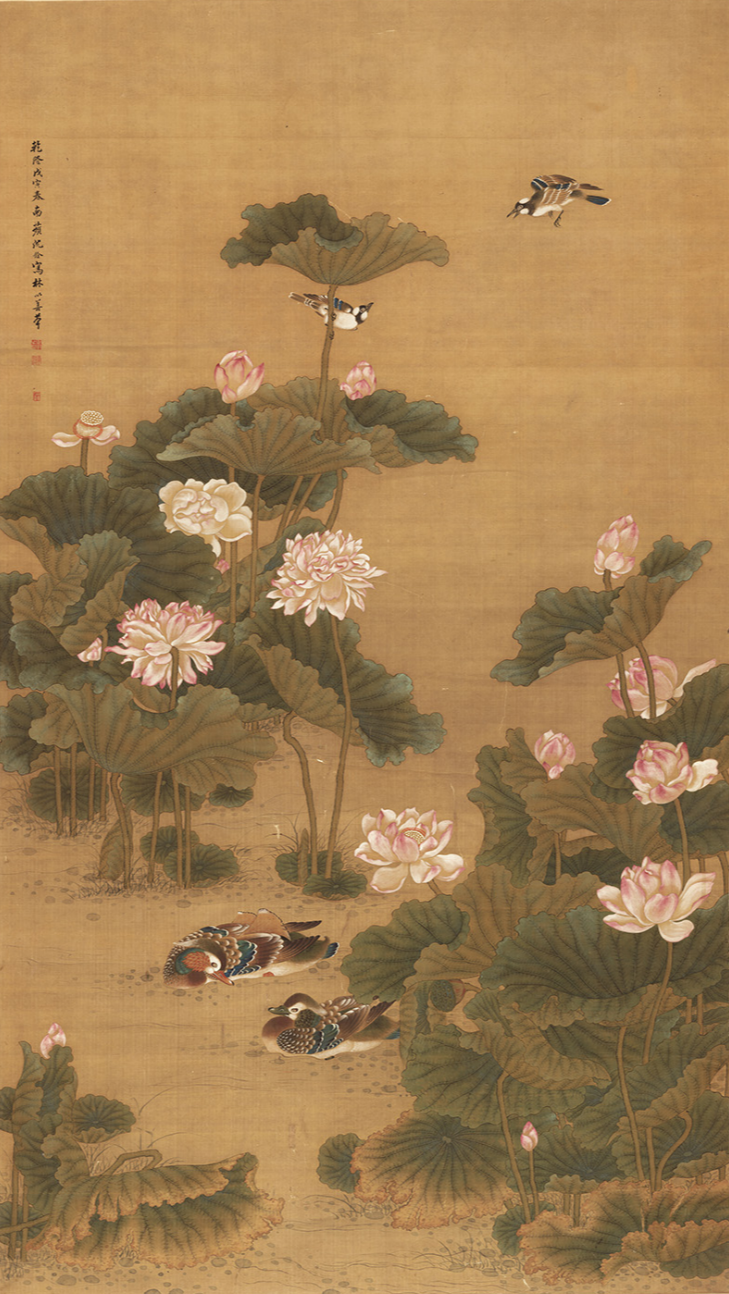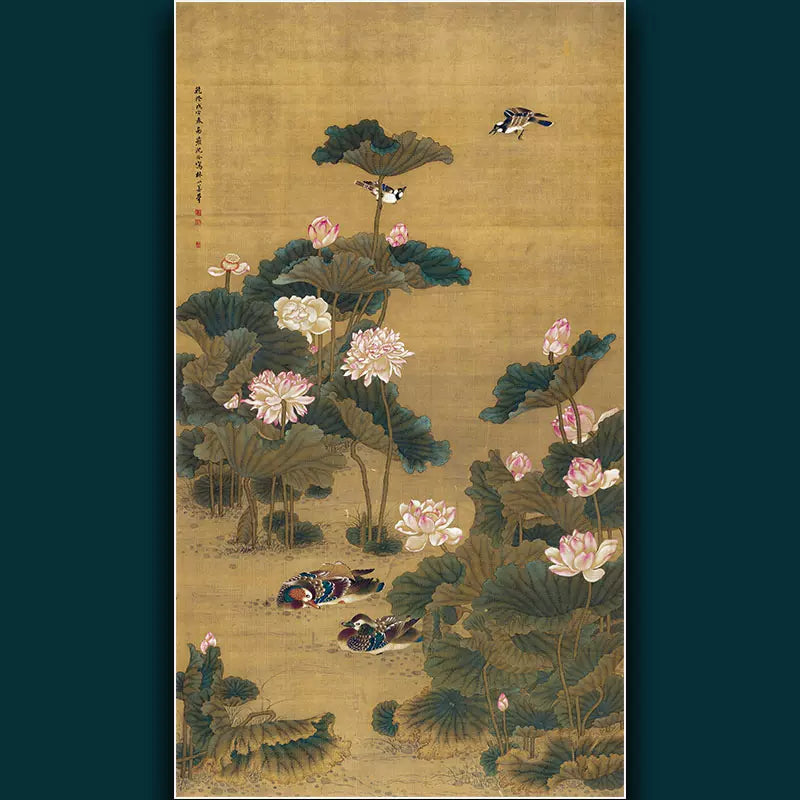荷塘鸳鸯图
Mandarin Ducks in a Lotus Pond
Mandarin Ducks in a Lotus Pond
Couldn't load pickup availability
Share
Shen Quan's "Mandarin Ducks in a Lotus Pond" - A Reproduction of a Qing Dynasty Masterpiece
Mandarin Ducks in a Lotus Pond is a celebrated painting by Shen Quan (1682–1760), a prominent artist of the Qing Dynasty known for his exquisite flower-and-bird paintings. This work captures the serene beauty of a lotus pond, where a pair of mandarin ducks—symbolizing love, fidelity, and marital harmony—swim gracefully among blooming lotuses and lush foliage. The painting is executed in the meticulous gongbi (fine brush) style, characterized by its vibrant colors, intricate details, and harmonious composition.
Shen Quan's mastery is evident in the delicate rendering of the lotus flowers, leaves, and water, as well as the lifelike portrayal of the mandarin ducks. The interplay of light and shadow, along with the rich yet balanced color palette, creates a sense of depth and vitality. The painting not only showcases the natural beauty of the scene but also conveys deeper cultural symbolism, reflecting traditional Chinese values of harmony, prosperity, and enduring love.
Shen Quan was highly influential in both China and Japan, where his works were admired for their technical brilliance and artistic elegance. His ability to blend realism with poetic sentiment made him a leading figure in Qing Dynasty art.
This reproduction faithfully captures the essence of the original, making it a treasured piece for collectors and admirers of classical Chinese art. It offers a glimpse into the refined aesthetic and cultural traditions of the Qing Dynasty, perfect for those who appreciate the harmony of nature, symbolism, and meticulous craftsmanship.
Shen Quan (c. 1682–1760) was a Chinese painter during the Qing dynasty (1644–1912). His courtesy name was Nanpin (南蘋) and his sobriquet was Hengzhai (衡斎). His works became influential in Japanese Edo period art.
Shen was born in Deqing in Zhejiang province. He specialized in bird-and-flower painting, and was influenced by Bian Jingzhao and Lü Ji. His works were painted in a very realistic style, and he had many students and patrons.
Shen was invited to Japan by a high official. He arrived in Nagasaki in the final month of 1731 with two students, acquiring many Japanese students after his arrival. His paintings soon became very popular, and after his 1733 return to China he continued to send paintings back to Japan. Shen had many pupils while in Japan; his most important was Kumashiro Yūhi, who in turn taught Sō Shiseki and Kakutei. Other artists influenced by Shen included Katsushika Hokusai, Maruyama Ōkyo, and Ganku.
Shen's paintings were popular for their realistic, coloured images of animals and flowers, and three-dimensional trees and rocks.
The painting style of Shen and his school would therefore be fruit of an artistic investigation. In their paintings, flora and fauna are not just “realistic”, but are styled just as they appear in Chinese and European treatises. Chinese and Western treatises on natural sciences could have played a key role in the spread of knowledge on subjects such as botany, zoology, and mineralogy, and that the images featured in these treatises might have inspired artists to choose and create new representations of bird-and-flower. That is why scholar Meccarelli has called the style of the Shen Nanping school “flora and fauna decorative painting”.
清代沈铨荷塘鸳鸯图真迹复制
沉铨(约 1682-1760 年)是清朝(1644-1912 年)的中国画家。 字南萍,号衡斎。 他的作品对日本江户时代的艺术产生了影响。
沉先生出生于浙江德清。专工花鸟画,受卞景照、吕机影响。 他的作品画风非常写实,有很多学生和赞助人。
沉应一位高级官员的邀请访问日本。 1731 年最后一个月,他带着两名学生抵达长崎,并在抵达后吸引了许多日本学生。 他的画很快就广受欢迎,1733年回到中国后,他继续将画作送回日本。 沉在日本期间有很多学生。 他最重要的是熊代雄日,他又教导了资石宗和角亭。 其他受沈氏影响的艺术家包括葛饰北斋、丸山大京和甘空。
沉的画作因其逼真的彩色动物和花卉图像以及三维树木和岩石而广受欢迎。
因此,沉及其流派的绘画风格是艺术考察的成果。 在他们的画作中,动植物不仅是“写实的”,而且风格与中国和欧洲论文中出现的一样。 中国和西方的自然科学论文可能在植物学、动物学和矿物学等学科知识的传播中发挥了关键作用,而这些论文中的图像可能会启发艺术家选择和创造新的花鸟类表现形式。因此学者麦卡莱利将沉画派的风格称为“动植物装饰画”。




